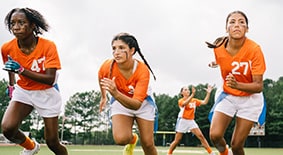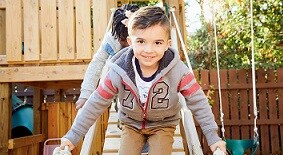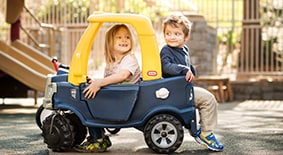When Your Kid Breaks a Bone, Don’t Panic. Here’s What You Should Do.
Bumps and bruises are an unavoidable part of childhood. Thankfully, an ice pack can ease the pain of many tumbles and falls, but it’s common for some falls to result in a broken bone. How do you know if a bone is broken, and what can you do about it?
Your kid fell while riding their bike and is crying in pain. The first thing you think of is, “Is their arm broken?” Here are some things to look for to help make that determination.
Severe breaks can cause a broken bone to poke through the skin, but most breaks aren’t so obvious. An exam by a doctor and an X-ray are necessary to confirm a broken bone.

Is it a broken bone or a sprain?
Sometimes, a broken bone and a sprain have similar symptoms. A sprain is a ligament injury. Ligaments are soft tissues that connect bones at a joint. Signs of a sprain often overlap fracture symptoms, with pain, swelling and bruising.
However, broken bone symptoms are typically more severe than a sprain. Often a child can’t even move the injured limb without extreme pain. The common signs of a broken bone are:
- Pain
- Swollen, bruised and/or crooked limb
- Difficulty moving the injured limb or pain when moving it
- Inability to move the injured limb like normal or put weight on it
Since children may not be able to judge the severity of any pain, if there’s any doubt, check it out! Depending on where the break is, your child may be able to use an injured area with only moderate pain or discomfort. Take your child to see a doctor or medical professional ASAP. X-rays and/or MRIs are the only sure ways to determine if there is a fracture.
First and foremost, if the break is severe with a bone coming through the skin, call 911. Do not move your child or try to push the bone back under the skin.
All broken bones need medical care to make sure the break heals properly. Until you are able to get your child to medical care, make your child as comfortable as possible. If there’s pain, but you don’t see a bone, use these steps to make your child comfortable until you get to the doctor.
- Cut away or gently remove clothing from the injured area if possible.
- Apply an ice pack wrapped in cloth to the area.
- Stabilize the injured area with a splint, or support it with a cushion or pillow. Use a strip of cardboard or a rolled-up newspaper secured with tape, an elastic bandage, or a scarf as a makeshift splint. A sling made from a towel or piece of clothing can also help keep an injured arm in place.
- Do not give your child anything to drink or eat in case surgery is required.
Getting the right care for broken bones cannot be understated. S. Clifton Willimon, MD, Medical Director for Orthopedic Outcomes and Quality at Children's Healthcare of Atlanta, says, “If you suspect your child has a broken bone, getting the right diagnosis and treatment are essential for proper healing.” Children’s Healthcare of Atlanta has three Emergency Departments and several Urgent Care Centers throughout the metro area, as well as many Children’s Physician Group–Orthopaedics and Sports Medicine locations that often can provide same-day appointments, giving you quick access to pediatric orthopedic specialists and treatment.
Why your child should see a pediatric specialist for a broken bone
Kids’ bones aren’t just smaller versions of adult bones. Your child’s bones are still growing, so where you take your child for treatment can have a long-term impact on how the bone heals. Pediatric-trained radiologists and orthopedic specialists understand kids’ different needs when it comes to diagnosing and treating broken bones.
“Unlike adults, kids often have fractures at growth plates, the specific parts of the bone where bone growth happens,” Dr. Willimon says. “If a growth plate is damaged and not treated correctly, it can slow or stop a bone’s growth or cause a bone to grow crooked.”
Breaks aren’t always obvious in kids’ bones. Because their bones are still growing, there’s more cartilage, which isn’t as dense as bone. Breaks can show up as gaps in the bones and joints.
Pediatric radiologists use X-rays to determine if your child has a broken bone. Breaks are also hard to see if they’re on a growth plate, so your child may need an MRI. The pediatric radiologists at Children’s follow Image Gently guidelines, customizing each child’s scan and using the lowest dose of radiation possible.
Weekend Clinic for Injuries
Sprains, strains and broken bones don’t wait for weekdays. If your child needs to see a pediatric orthopedic expert on a weekend, Children’s has appointments available on Saturdays in Sandy Springs and Sundays in Duluth. Make an appointment online or call 404-255-1933 to schedule.
Make an AppointmentS. Clifton Willimon, MD, is a board-certified Orthopedic Surgeon, Medical Director of the Atlanta United Academy, and Medical Director for Orthopedic Quality and Outcomes at Children’s Healthcare of Atlanta. He specializes in disorders of the knee, hip, shoulder and elbow. Dr. Willimon practices advanced arthroscopic and reconstructive surgical techniques for the treatment of complex disorders of the hip, knee, shoulder and elbow, as well as all sports-related injuries.
This content is general information and is not specific medical advice. Always consult with a doctor or healthcare provider if you have any questions or concerns about the health of a child. In case of an urgent concern or emergency, call 911 or go to the nearest emergency department right away. Some physicians and affiliated healthcare professionals on the Children’s Healthcare of Atlanta team are independent providers and are not our employees.
Contact Us 404-255-1933




